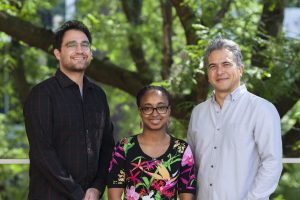
Research Explores Mistrust in Health & Science Communication
Although many of us may have a mistrust of institutions, history and lived experience have made these feelings particularly acute for Black Americans who have faced persistent institutional oppression. How do you trust communication about science and health when those voices of authority have done real harm in the past? And how can misinformation best be countered when mistrust itself can be protective? A team of researchers collaborating across Communication Arts and Life Sciences Communication have just won a prestigious National Science Foundation grant to explore these questions and help science and health communicators engage in more effective dialogue with Black communities that is responsive to lived experiences of racism and inequity.
The research team is led by Professor Mike Xenos (former professor and chair in Communication Arts), who studies science and political communication in the Department of Life Science Communication. He is joined by his LSC colleague, Assistant Professor Todd Newman and Communication Arts Assistant Professor Lillie Williamson. Together, this interdisciplinary team has secured almost $600,000 from NSF to explore how Black American experiences shape their reception of science and health communication, with an eye to developing strategies that will take this mistrust seriously and incorporate it into the communication process.
As Communication Arts’ expert in health communication, Professor Williamson’s contributions examine the mistrust of medical professionals and their expertise to develop new and innovative solutions for managing misinformation. The COVID-19 health crisis made hesitancy to trust the medical establishment and the public dangers of misinformation all-too-familiar. However, much of the research around these problems adopts a one-size-fits all approach without acknowledging how historical and lived experiences of racism play a unique role in how Black Americans may encounter and process medical and, more broadly, scientific misinformation. Williamson is skeptical of approaches that are simply aimed at reducing mistrust. Instead, she suggests: “Mistrust needs to be acknowledged as a protective, adaptative strategy for oppressed communities. How do we incorporate that into the decision-making processes used in health communication?”
To answer questions like this, the research team will examine inequity- and inequality-based science mistrust (and the reasons for those concerns) within Black communities in Wisconsin. By conducting community conversations and focus groups alongside surveys and message testing, the team promises to generate a dialogue so that the research can be rooted in the real concerns of Black communities. By doing so, the research can help build more mutually beneficial relationships with those communities, co-developing strategies and resources to solve the problems they identify as priorities in the future. Williamson worries about past research that has been “extractive” and wants to instead find ways to benefit the communities that are partnering in this dialogue.
As a means of generating dialogue in communication research, the project is also notable for uniting its research team across different disciplines. The project will establish more robust conversations between science communication and health communication. Although these two disciplines sound similar, there remains significant room for the two scholarly literatures to talk to each other—even as suggested by the division between Communication Arts and Life Sciences Communication on the UW-Madison campus. This project closes the gap and encourages needed conversation in both fields about not only community-centered but also culturally responsive communication strategies.